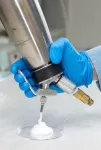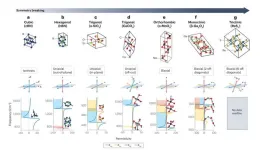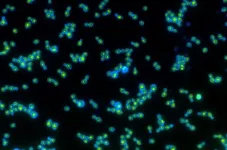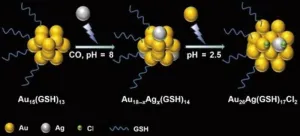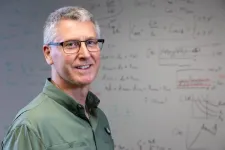(Press-News.org) AUSTIN, Texas — The recent firing and rapid rehiring of Sam Altman, the co-founder and CEO of ChatGPT creator OpenAI, illustrates the delicate dance between visionary CEOs and the boards who oversee them.
Some CEOs — often founders — are fueled by strong convictions about the strategic direction their companies should take. But their boards sometimes don’t share their visions.
When that happens, what is the board’s role in governance? Should it monitor or advise the CEO? Should it back off and approve the CEO’s strategy?
The answer depends on how deeply the CEO is invested in the strategy, says Volker Laux, professor of accounting at Texas McCombs and Randal B. McDonald Chair in Accounting. In new research with co-author Xu Jiang of Duke University, Laux built a model of board/CEO relationships, in which a CEO has a strong belief about the state of the industry and the strategy they've created.
The board, representing shareholders’ interests, gathers information to either confirm the CEO’s plan or recommend a switch. But how much effort the board puts into gathering that information — and whether it uses that data to persuade or overrule the CEO — depends on how strongly the manager believes in their vision, the model shows.
Persuadable CEO. If the CEO is only “mildly overconfident,” says Laux, the board will invest more resources to collect information and give advice. In this scenario, if the information shows the strategy is not the right one, the CEO listens and changes direction.
High-Confidence CEO. Sometimes, the CEO has a higher level of confidence and no longer listens to the board’s advice — even if its information suggests the vision is wrong. In such a situation, the board’s best course is to act as a monitor, with the option of overruling the CEO if the accumulation of information supports a new strategy. The stronger the CEO’s belief bias, the less information the board will collect, the model finds.
Very High-Confidence CEO. If the CEO is a visionary who strongly believes in their ideas, the board may decide not to intervene, even if it’s convinced a new direction would better serve shareholders. In this case, the board rubber-stamps the CEO’s strategy, because the CEO will be highly motivated to make it succeed.
“It can actually be optimal to be passive,” says Laux. “You often hear that boards are too passive and rubber-stamp the CEO’s vision or ideas, but our setting shows that in certain situations, it can be the right move.”
The alternative — forcing a visionary CEO to change strategy — could backfire by depleting the CEO’s enthusiasm and derailing the company’s progress. It could ultimately mean replacing the CEO. Both scenarios would be costly to shareholders, as the back-and-forth conflict between Altman and his board demonstrates.
“If the loss of motivation would be substantial, the board won’t insist on a strategy shift,” Laux says. “They will just let the CEO run with his idea.”
“What Role Do Boards Play in Companies with Visionary CEOs?” is published in Journal of Accounting Research.
Story by Sally Parker
END
How should boards handle visionary CEOs?
New research offers practical, nuanced strategies for boards overseeing confident leaders
2024-01-12
ELSE PRESS RELEASES FROM THIS DATE:
Drinkable, carbon monoxide-infused foam enhances effectiveness of experimental cancer therapy
2024-01-12
Did smokers do better than non-smokers in a clinical trial for an experimental cancer treatment? That was the intriguing question that led University of Iowa researchers and their colleagues to develop a drinkable, carbon monoxide-infused foam that boosted the effectiveness of the therapy, known as autophagy inhibition, in mice and human cells. The findings were recently published in the journal Advanced Science.
Looking for ways to exploit biological differences between cancer cells and healthy cells ...
Light-matter interaction: broken symmetry drives polaritons
2024-01-12
An international team of scientists provide an overview of the latest research on light-matter interactions. A team of scientists from the Fritz Haber Institute, the City University of New York and the Universidad de Oviedo has published a comprehensive review article in the scientific journal Nature Reviews Materials. In this article, they provide an overview of the latest research on polaritons, tiny particles that arise when light and material interact in a special way.
In recent years, researchers worldwide have discovered that there are different types of polaritons. Some of them can trap light in a very small space, about the size of a nanometer. That's ...
Neuroscientists identify 'chemical imprint of desire'
2024-01-12
Hop in the car to meet your lover for dinner and a flood of dopamine— the same hormone underlying cravings for sugar, nicotine and cocaine — likely infuses your brain’s reward center, motivating you to brave the traffic to keep that unique bond alive. But if that dinner is with a mere work acquaintance, that flood might look more like a trickle, suggests new research by University of Colorado Boulder neuroscientists.
“What we have found, essentially, is a biological signature of desire that helps us explain why we want to be with some people more than other people,” said senior author Zoe Donaldson, associate professor ...
Trends in cancer mortality disparities between Black and white individuals in the US
2024-01-12
About The Study: Although U.S. age-adjusted cancer mortality rates declined significantly between 2000 and 2020, substantial racial and ethnic disparities persisted for many common and preventable cancers, including female breast and male colorectal cancer. Cancer disparities arise from a confluence of factors, including structural racism, medical mistrust, health care access inequities, poor socioenvironmental conditions, aggressive tumor biology, and genetic ancestry.
Authors: Tomi Akinyemiju, Ph.D., M.S., of the Duke University School of Medicine in Durham, North Carolina, is the corresponding author.
To access the embargoed study: Visit our For The Media website ...
Medicaid expansion under the Affordable Care Act and early mortality following lung cancer surgery
2024-01-12
About The Study: In this study of nearly 15,000 adults with non–small cell lung cancer, Medicaid expansion was associated with declines in 30- and 90-day postoperative mortality following hospital discharge. These findings suggest that Medicaid expansion may be an effective strategy for improving access to care and cancer outcomes in this population.
Authors: Leticia M. Nogueira, Ph.D., M.P.H., of the American Cancer Society in Atlanta, is the corresponding author.
To access the embargoed study: Visit our For The Media website at this link https://media.jamanetwork.com/
(doi:10.1001/jamanetworkopen.2023.51529)
Editor’s ...
Researchers create light-powered yeast, providing insights into evolution, biofuels, cellular aging
2024-01-12
You may be familiar with yeast as the organism content to turn carbs into products like bread and beer when left to ferment in the dark. In these cases, exposure to light can hinder or even spoil the process.
In a new study published in Current Biology, researchers in Georgia Tech’s School of Biological Sciences have engineered one of the world’s first strains of yeast that may be happier with the lights on.
“We were frankly shocked by how simple it was to turn the yeast into phototrophs (organisms that ...
2023: the warmest year on record globally
2024-01-12
Globally 2023 was the warmest year in a series stretching back to 1850, according to figures released today by the Met Office and the University of East Anglia.
2023 is the tenth year in succession that has equalled or exceeded 1.0 °C above the pre-industrial period (1850-1900).
The global average temperature for 2023 was 1.46 °C above the pre-industrial baseline; 0.17 °C warmer than the value for 2016, the previous warmest year on record in the HadCRUT5 global temperature dataset which runs from 1850.
Dr Colin Morice is a Climate ...
Researchers develop technique to synthesize water-soluble alloy nanoclusters
2024-01-12
In recent years, ultrasmall metal nanoclusters have unlocked advances in fields ranging from bioimaging and biosensing to biotherapy thanks to their unique molecular-like properties. In a study published in the journal Polyoxometalates on December 11, 2023, a research team from Qingdao University of Science and Technology proposed a design to synthesize atomically precise, water-soluble alloy nanoclusters.
“The novelty of this study is in a new strategy for the synthesis of water-soluble alloy nanoclusters and a further contribution ...
Clinical predictive models created by AI are accurate but study-specific
2024-01-12
In a recent study, scientists have been investigating the accuracy of AI models that predict whether people with schizophrenia will respond to antipsychotic medication. Statistical models from the field of artificial intelligence (AI) have great potential to improve decision-making related to medical treatment. However, data from medical treatment that can be used for training these models are not only rare, but also expensive. Therefore, the predictive accuracy of statistical models has so far only been demonstrated in a few ...
$900,000 awarded to optimize graphene energy harvesting devices
2024-01-12
U of A physics professor Paul Thibado received a commitment of $904,000 from the WoodNext Foundation, administered by the Greater Houston Community Foundation. The five-year grant will support Thibado’s development of graphene energy harvesters.
“We have successfully developed a process for building graphene energy harvesting device structures,” Thibado said, “but current structures do not harvest enough power. This proposal will allow us to optimize these structures to harvest nanowatts of power, which is enough energy to run sensors.”
Thibado and his colleagues will develop graphene energy harvesting ...
LAST 30 PRESS RELEASES:
Global societies unite to address environmental threats to heart health
Artificial light at night extends pollen season
Women see AI as riskier than men do
Push and pull in models of human migration
Mapping comedic timing, ta-da!
SEOULTECH researchers reveal strong public support for hydrogen fuel cell trucks
Dongguk University develops a new way to produce cheaper, more efficient green hydrogen
Scientists discover a hidden RNA “aging clock” in human sperm
New quantum boundary discovered: Spin size determines how the Kondo effect behaves
Ancient ‘spaghetti’ in dogs’ hearts reveals surprising origins of heartworm
Full value added tax on meat: a first step towards pricing the environmental damages caused by diets
Hidden mpox exposure detected in healthy Nigerian adults, revealing under-recognized transmission
Shingles vaccine linked to slower biological aging in older adults
A self-assembling shortcut to better organic solar cells
A two-week leap in breeding: Antarctic penguins’ striking climate adaptation
Climate risks to insurance and reinsurance of global supply chains
58% of patients affected by 2022 mpox outbreak report lasting physical symptoms
Golden Gate method enables rapid, fully-synthetic engineering of therapeutically relevant bacteriophages
Polar weather on Jupiter and Saturn hints at the planets’ interior details
Socio-environmental movements: key global guardians of biodiversity amid rising violence
Global warming and CO2 emissions 56 million years ago resulted in massive forest fires and soil erosion
Hidden order in quantum chaos: the pseudogap
Exploring why adapting to the environment is more difficult as people age
Society for Laboratory Automation and Screening welcomes new scientific director: Madeline M. Farley, Ph.D.
Austrian cow shows first case of flexible, multi-purpose tool use in cattle
Human nasal passages defend against the common cold and help determine how sick we get
Research alert: Spreading drug costs over the year may ease financial burden for Medicare cancer patients
Hospital partnership improves follow up scans, decreases long term risk after aortic repair
Layered hydrogen silicane for safe, lightweight, and energy-efficient hydrogen carrier
Observing positronium beam as a quantum matter wave for the first time
[Press-News.org] How should boards handle visionary CEOs?New research offers practical, nuanced strategies for boards overseeing confident leaders
